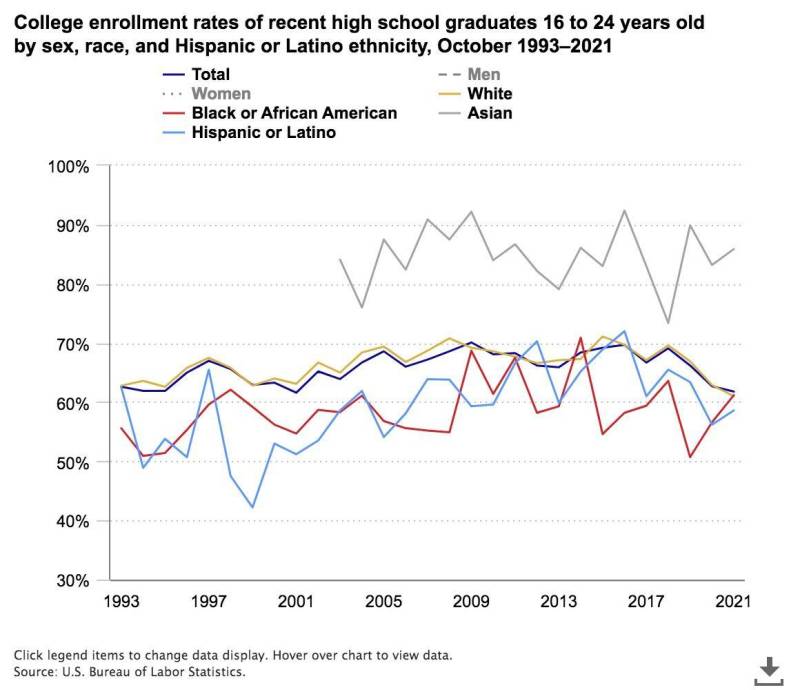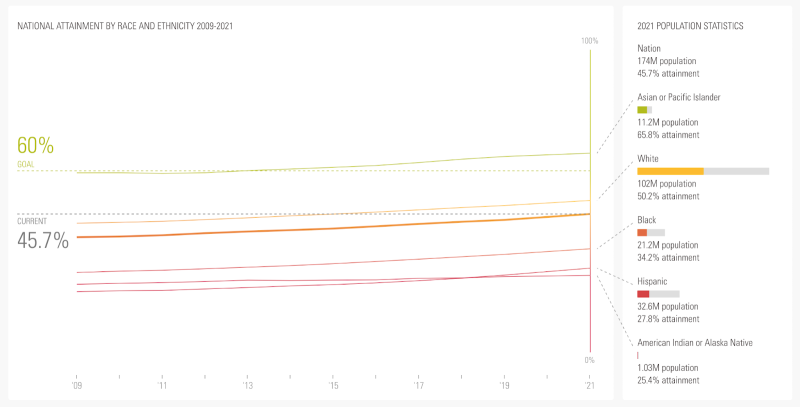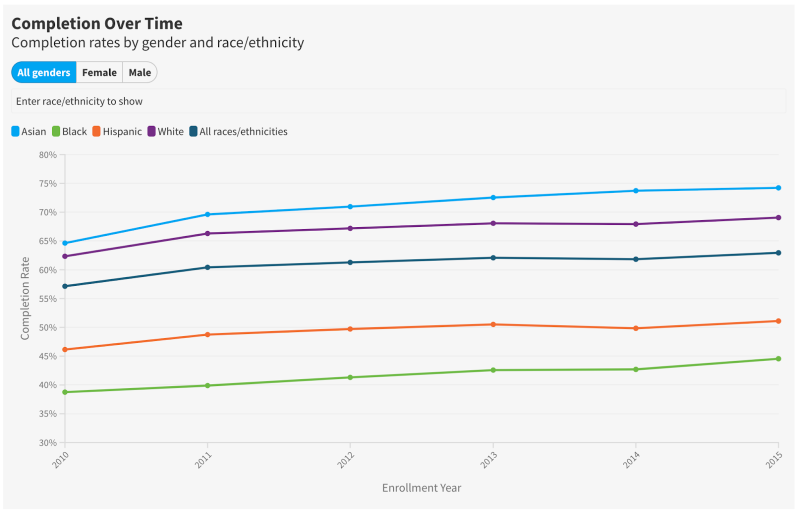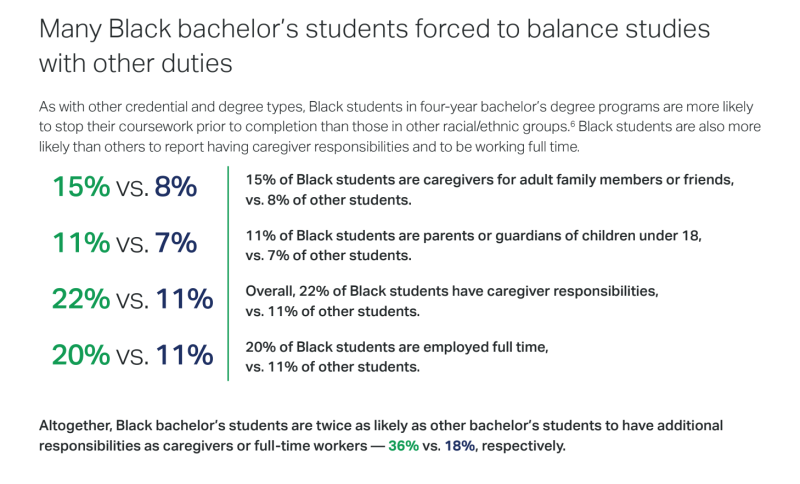How ought to we take into consideration these school enrollment numbers? Do they largely mirror every racial and ethnic group’s share of the inhabitants? I used to be stunned to study that the reply is sure – with a couple of caveats. Asian People are barely overrepresented on school campuses and Hispanic People are barely underrepresented.
I created this chart under, evaluating the Nationwide Scholar Clearinghouse’s school enrollment knowledge for 2020 with the younger grownup inhabitants, as reported by the united statesCensus, so you’ll be able to see how intently school enrollment tracks precise demographics.

One other approach to take a look at school enrollment is to see what number of younger adults enroll in school. The chart under, by the U.S. Bureau of Labor Statistics, exhibits that the faculty enrollment charges of Black and Hispanic younger adults improved after the 2008 recession, and approached the faculty going price of white People. Roughly 60 p.c of younger Black, Hispanic and white People try for a school diploma. The faculty going price for Asian People is far larger; greater than 80 p.c enroll. The zigs and zags on this chart present how school going amongst Hispanic and Black People is influenced by enterprise cycles.

The Bureau of Labor Statistics obtains enrollment knowledge from the Present Inhabitants Survey (CPS), a month-to-month survey of households performed by the Bureau of Census. (Right here is the chart on the BLS site.)
When jobs are plentiful, many low-income college students could be a part of the labor power and defer their larger training. That particularly reduces enrollments amongst Black and Hispanic younger adults, amongst whom poverty charges are larger. When unemployment is excessive, extra younger adults enroll in school, notably at two-year group schools. Most lately, throughout the pandemic, many younger People deferred school to assist help or care for their households. Some college students selected to attend till in-person courses resumed.
Going to varsity is one factor; ending it’s one other. This fourth chart, produced by the Lumina Basis, exhibits that over time, extra People of each race and ethnicity are incomes school levels. The Lumina Basis is a non-public basis that seeks to extend the variety of school graduates and was shaped via the sale of Sallie Mae, which created, serviced and picked up month-to-month funds on scholar loans. It’s also among the many many funders of The Hechinger Report.
Share of grownup inhabitants, ages 25-64, with school levels

This chart above, initially printed here on Jan. 31, relies on knowledge from the U.S. Census Bureau’s American Neighborhood Survey. It tracks the proportion of adults 25 to 64 with two-year affiliate and four-year bachelor’s levels. The share of People with a school diploma rose from 38 p.c in 2009 to just about 46 p.c in 2021 – a rise of eight proportion factors.
Each race and ethnicity noticed good points. The eight-percentage level acquire was the identical for each Black and white adults.
However racial gaps proceed. In 2021, there remained an unlimited 40 proportion level distinction between Asian American adults, amongst whom 66 p.c have a school diploma, and Native American adults, amongst whom solely 25 p.c have a school diploma. Amongst Black adults, 34 p.c have school levels. Amongst Hispanic adults, it’s 28 p.c and amongst white adults, it’s 50 p.c.
Enhancements in school attainment can appear sluggish as a result of commencement charges are a lot decrease amongst People over 35. It takes years for larger school commencement charges amongst youthful adults to boost total school numbers. Faculty attainment charges have jumped the quickest amongst younger Hispanic adults beneath age 35, rising from under 20 p.c in 2009 to above 30 p.c in 2021. Courtney Brown, the chief knowledge and analysis officer at Lumina, credit a wide range of help applications, from tutoring to meals pantries, and the comfort of on-line programs to elucidate why extra younger persons are graduating, regardless of rising tuition prices. “Faculties try to serve college students higher,” mentioned Brown. “Even the way in which they employees schools, not all on getting enrollments however having extra success coaches accessible and counselors serving to college students get to the end line.”
Nonetheless, Brown acknowledges that it’s been tough to make a dent within the cussed gaps in school attainment between individuals of various races and ethnicities. “Sadly, everyone seems to be rising,” Brown mentioned. “And so we aren’t seeing these gaps decreased.”
The Nationwide Scholar Clearinghouse’s DEI Information Lab additionally exhibits this completion downside starkly.

This chart tracks cohorts of scholars who started school on the similar time and calculates what number of of them earned any school diploma inside six years. Amongst college students who began school within the fall of 2010, 62 p.c of white college students accomplished a level by the summer season of 2016, in contrast with solely 39 p.c of Black college students. That’s an enormous 23 proportion level hole, and an indication {that a} disproportionate variety of Black college students are dropping out of faculty in debt. Completion charges improved significantly for college kids who began school in 2015, however giant gaps stay. Virtually 70 p.c of white college students accomplished a level by the summer season of 2021, however solely 45 p.c of Black college students hit this milestone. The Black-white school completion hole truly widened barely from 23 to 24 proportion factors.
The explanations for why completion charges stay a lot decrease for Black, Hispanic and Native American college students are complicated. These college students usually tend to attend group schools, which have decrease funding per scholar and fewer help providers. Many college students weren’t adequately ready in excessive colleges to deal with college-level coursework, particularly in math.
A poll of Black college students by Gallup-Lumina, launched on Feb. 9, discovered that 21 p.c of Black college students report feeling discriminated in opposition to often or often on the school they’re attending, and that 45 p.c have thought of dropping out prior to now six months. Black college students in bachelor’s applications are way more more likely to juggle household and work obligations alongside their research.
“Black college students are encountering a lot extra discrimination, and so they have a number of obligations that no different race or ethnicity actually has,” mentioned Lumina’s Brown. “A whole lot of it’s that Black college students usually tend to have kids. Working full time, having kids and making an attempt to get a bachelor’s diploma on the similar time is simply clearly overwhelming.”

On Feb. 2, the Nationwide Scholar Clearinghouse Analysis Middle launched the latest school enrollment numbers for 2022. Undergraduate enrollment for each white and Black college students fell for the fifth straight 12 months, whereas enrollment of Hispanic and Asian college students at public two-year schools improved. Nevertheless, their numbers are under pre-pandemic ranges. For instance, there have been roughly 975,000 Hispanic college students enrolled in public two-year schools, additionally referred to as group schools, within the fall of 2022, up from 944,000 within the fall of 2021, however significantly down from 1.14 million in 2019. (Click on here and navigate to the demographics tab for these fall 2022 charts.)
And right here’s a startling knowledge level: Black scholar enrollment at two-year group schools declined by a staggering 44 p.c, from 1.2 million in 2010 to 670,000 in 2020, in line with a Sept. 2022 report by the Joint Middle for Political and Financial Research, a suppose tank that research coverage points affecting Black People.
Fewer college students in school now definitely means fewer college-educated adults within the years forward. And that’s not a promising future.
















